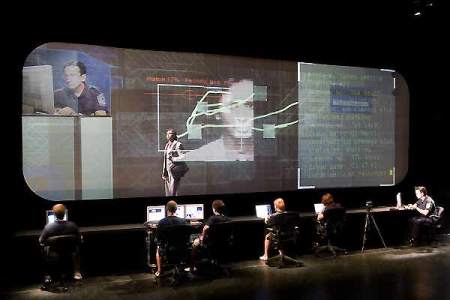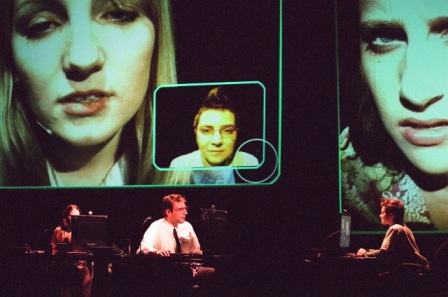ateatro 116.17
Digital Divide e teatro
Un'intervista a Marianne Weems (The Builders Association)
di Anna Maria Monteverdi
Marianne Weems è l’ideatrice della compagnia tecnoteatrale statunitense The Builders Association specializzata in allestimenti teatrali riccamente dotati di tecnologia digitale e schermi panoramici e che nel 2004 ha portato a RomaEuropa il pluripremiato Alladeen, storia non così fiabesca di dipendenti di un call center di Bangalore, vincitore anche di un Obie Award. La tecnologia è sempre presente sia materialmente sia come argomento stesso degli spettacoli: il divario tecnologico tra Paesi civilizzati e terzo mondo, lo sfruttamento dei lavoratori attraverso nuovi sistemi telematici di lavoro a distanza, la simulazione degli eventi da parte dei media, la mediazione tecnologica che entra in ogni azione della nostra vita, il controllo elettronico. Siamo di fronte a un genuino caso di teatro politico tecnologico, giocato sempre su una scenografia straordinariamente self-evident e di notevole impatto visivo.

Supervision è la loro ultima produzione. Sono tre storie che parlano della violazione della privacy e del controllo e monitoraggio in tempo reale di liberi cittadini: vite che diventano trasparenti a cominciare dalle transazioni economiche e dagli spostamenti da loro effettuati, dallo stipendio che arriva loro in banca, dai loro incontri negli spazi pubblici sorvegliati. Marianne Weems mette in scena storie di ordinario pirataggio dati in epoca post-privata, legate al filo (o file...) comune della propria identità personale diventata informazione ramificata, incontrollabile, separata dal corpo fisico e che viaggia dentro migliaia di processori in uno spazio-dati invisibile. Persone che vivono nel white noise della costante connessione remota, viaggiatori bloccati alla frontiera a causa di controlli che incrociano informazioni strettamente personali con quelle dell' AIDC (Automatic Identification and Data Capture).

Marianne Weems (che ha lavorato come dramaturg e assistente alla regia di Elizabeth LeCompte e Richard Foreman) ha dato visibilità e concretezza palpabile a questi databodies, a questa infosfera immateriale attraverso un'imponente architettura fatta di uno schermo panoramico, proiezioni video multiple real time, animazioni computerizzate e un sistema di motion capture.
http://it.youtube.com/watch?v=jlTpsTAKDGY
Which have been the most important developing steps of your group, The Builders Association: when was it born, which is your background, and which have been the artistic models for your idea of digital performance?
We started 14 years ago by building a full-scale, “deconstructed” (Gordon Matta-Clark-inspired) house within an enormous industrial space. The house was lined with video and sound triggers which the performers activated as they moved through the house performing the Ibsen play “The Master Builder.” It was a utopian moment – the show, the house, and eventually the company emerged in that 8 months of collaboration which involved architects, software designers, film and video makers, sound and lighting designers, live musicians, and of course the performers.
I create and direct productions based on real stories drawn from contemporary life -- stories that have accessible, timely, relevant content and that reflect modern human experience. Over the last 14 years with my company The Builders Association I’ve made performances about data theft, about outsourcing, and even about jet lag. That sounds a bit dry, somehow, but the productions are big, colorful, sometimes funny, and very much about human beings wrangling with the 21st century. I’ve been told that these stories speak to a broad range of people outside of the world of experimental theater, to artists working in many other media, and to younger audience members as well as old. In this attempt to hold a mirror up to our chaotic contemporary world, I work with traditional theater actors and designers, and less traditional collaborators such as video, sound, and software designers, architects, and more. These productions have all toured extensively -- from BAM to Bogotá, Singapore to Melbourne, Minneapolis and Los Angeles to Budapest -- and have engendered passionate audience discussions about the changing nature of identity, labor, life, speed, and travel. I want to expand theater, to combine entertainment with critical thinking –and to invite the viewers to investigate the invisible networks that surround us.
How do you think is possible to achieve that interfacing and advanced technology are to be considered integral part of “aesthetic intention”?
The Builders’ projects set up a frictive relationship between the liveness of the performers and the liveness of technology, creating a kind of web of media around the performers, which they and technical operators “play” and animate in each show.
Steve Dixon proposes a definition for digital performance: “enhanced theatre” or “augmented theatre”, other “postdramatic Theatre”; how do you prefer to define your work?
We create original productions based on stories drawn from contemporary life. The company uses the richness of new and old tools to extend the boundaries of theater.
Can you talk about the common creative processes behind your shows?
These projects are built in a very inclusive manner – all of the technology, the designers, the writers, and the performers are present in very early rehearsals. This practice has allowed us to develop projects in which the technology is truly integrated into the productions – the content and form are interlinked on a deep dramaturgical level.
I was very surprised from the themes of your works which has a clearly political attack or critic against multinationals who holds economically power thanks to technology, against the way the mass media distorts facts, about, globalization (as in Alladin), the society of control (as in Jet Lag). Which is the starting point of your works and which is the real goal? ….
Our projects act as a springboard for political observation and discussion in each venue they’re presented in. For instance, when we presented Alladeen at the Barbican Centre in London there were riots going on since British Telecom had just outsourced thousands of jobs to India, and there were similar demonstrations going on in Seattle (because of Microsoft) and even in Bogota when we were there.
Supervision has a powerful scenography and the message is immediately: the negative use of technology against the individual, against his freedom; an use distorted and manipulated by government but also by ourselves which we prefer to have more and more mediated relationships and less human contacts. Do you think persons have the consciousness of this abuse, about these excesses, also of the digital divide all over the worlds?
All of our projects have to do with using technology to tell stories about technology and complications of identity – rich stories, real stories that are drawn from contemporary events. Each project looks at the cultural artefacts and effects of mediatization; through this lense we have engaged with subjects as disparate as travel (Jet Lag which we developed with the architects Diller + Scofidio), outsourcing (Alladeen, developed with the South Asian company motiroti), and of course the data sphere in Super Vision, which we developed with dbox.
Which was the contribution of the web on the diffusion of your work ?
More recently I have tried to reach outside of the proscenium space to those who have no interest in or access to theater. There are websites that accompany these productions where thousands of people have shared their thoughts and wishes. My next show Continuous City asks viewers to generate material that will be integrated nightly into the show. For me this is a big risk, creating a large-scale, high tech performance that is variable night to night and responds to the location, participation, and preoccupations of the audience. I’ve also begun working with ‘at risk’ students in Brooklyn on a long-term production (which they are probably blogging even as I write) called Invisible Cities.
I feel that each of my shows builds on broader perspectives, whether it’s the high schools of central Brooklyn, the call centers of South Asia, or the networked reach of global cities. I have gone from making pieces for myself and my closest collaborators, to embracing and evoking a bigger world.
Large part of Technology Theatre is based on the long period, using a work in progress concept going through various in-between steps (sometimes as labs), through which every single part of the show can achieve his own full autonomy (movie, video, web-site, etc.).You also use this modality? Is it for an economic problem only?
It takes time to fundraise and to literally to build these shows – there are a lot of people involved and a lot of phases of development. Of course if the funding were already in place it’s possible we could move at a faster pace, but this is the way it’s developed so far.
I should add also that each project tours for at least two years after it’s premiere, so there is a justification which balances the long development periods.
Do you think audience has the right tools for a right comprehension of this theatre?
In Europe yes. In the U.S. comprehension is growing daily...
Which is your knowledge of the Italian artists and groups using technology on stage?
Romeo Castallucci is my hero.
Are you planning a tour in Italy?
We would like to return to RomaEuropa, we presented Alladeen there in 2004 and had a good time.
|
© copyright ateatro 2001, 2010
|
Se cerchi (e se vuoi comprare) su ibs un libro o un autore di cui si parla in questa pagina
|
|
|
|
|

